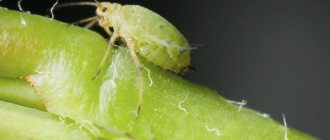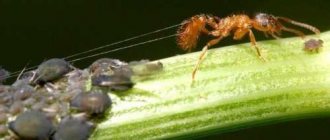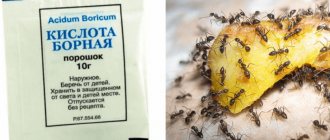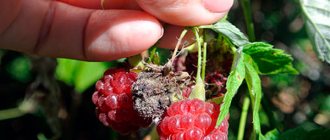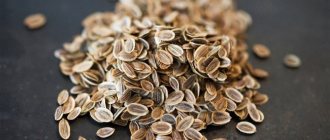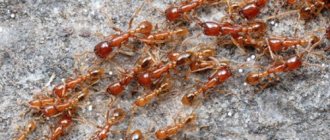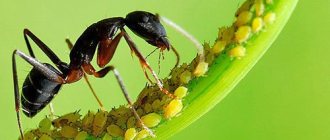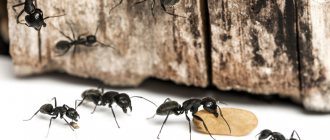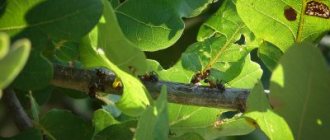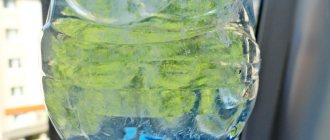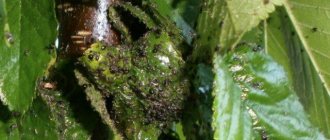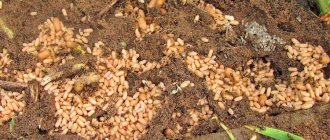Causes and consequences of the appearance of ants
Few people know why insects appear in these plants. There are three reasons for this:
- Hunting for nectar. The nectar contained in peonies contains many nutrients for these insects.
- Good defense. Setting up a nest under peony bushes is due to the fact that in such places you can perfectly camouflage the ant’s home.
- Food for aphids. Everyone knows that ants spread aphids, which eat the buds and petals of peonies.
Important! If insects are not removed in a timely manner, the flowers will be spoiled and the ants and aphids will move to other plants.
Having understood the causes and consequences of the fact that insects infest peonies, you should study the features of pest control.
Why do ants appear on peonies?
The ants' diet largely consists of carbohydrates, which they obtain by feeding on honeydew and the sweet nectar of certain plants. Insects are attracted to the sharp, sweet aroma of peony, emanating even from unopened flowers. Ants that settle on buds feed on the juice that has already been released; very rarely they gnaw through the bud in search of nectar.
On a note! Buds damaged by ants dry out or bloom, but the flowers become deformed and discolored.
If insects have already settled on peony bushes, they will bring aphids to them, which, in the process of vital activity, secrete honeydew - a food source for ants. Aphids reproduce very quickly, they destroy young leaves, buds and even peony flowers. Due to impaired photosynthesis, plants lose immunity to infections and cold resistance decreases.
How to deal with the invasion?
It is necessary to fight ants on peonies immediately when they are detected. Otherwise, they will eat all the nectar, as a result of which the flower will dry out and wither. There are three options for protecting flowers from these pests, which will help save peonies from ants and aphids:
- toxic chemicals;
- mechanical methods (traps);
- folk methods.
Let's look at each of them in more detail.
Chemical methods
Chemical-type products are not considered the most effective option for fighting insects, since if you spray flowers, you can only protect them from ants for a while. In addition, treatment can destroy not only pests, but also beneficial insects (for example, bees that pollinate flowers).
Let's look at various chemicals that can help get rid of ants for good.
Ant-eater
The Anteater product is available in two forms: liquid and powder. The drug is based on a strong poison (diazinon). The product has a damaging effect on the gastrointestinal tract of insects, as a result of which the ants die. To destroy the main skeleton and drive away the surviving insects, it is enough to spray the anthill with the bush.
You can purchase the drug for 60 rubles.
Expel
"Expel" is a German powdered drug. The drug is based on two percent chlorpyrofos. The drug is available not only in powder form, but also in liquid form. It works great, but one condition is important. If you do not follow all the rules specified in the instructions, you can harm not only your health, but also your pets.
The price of the drug is about 140 rubles.
Pyrethrum
Powdered product "Pyrethrium" is a drug with contact action. Once on the skin, toxic substances quickly penetrate the body. Thanks to the increasing concentration, the product spreads quickly.
The powder affects the nervous system, blocking the supply of impulses, which causes disruption of the body's life support system. As a result, insects cannot move, are deprived of the opportunity to look for food, and all organs are paralyzed.
You can purchase the product for 460 rubles.
Antiant
The drug in the form of granules contains ten percent borax. It is scattered in places where anthills actively accumulate in order to destroy pests.
The price of the drug is from 40 rubles.
Trap Raptor
The gel-shaped product is poured near ant paths, on peony bushes and on the homes of parasites.
The product costs about 270 rubles.
Global Taracid
The drug is available in the form of a gel. Before use, the tube is kneaded, then the product is applied to strips of cardboard (paper) 15*2 cm. The finished sheets are placed in places where insects are expected to accumulate and along their routes. Treatment is repeated after 14 days.
The cost of the drug is about 200 rubles.
Karbofos
The drug is considered a prophylactic agent used during the formation of flower buds. It is considered a kind of protection against insect invasion.
The price of the drug is from 30 rubles.
Fas-Double
The drug has a paralytic effect. Once inside the ant's body, it ultimately leads to the death of the insect. Life expectancy depends on the amount of substance that enters the gastrointestinal tract. The drug is transmitted to other insects through the legs and abdomen. Within 14 days, the ants die en masse.
Fas Double from ants, how to use the powder, read more in this article.
The cost of the drug is about 40 rubles.
Summer resident
The drug is available in liquid form. The product dissolves in water at the rate of five milliliters of the substance per eight liters of water. The drug is sprayed with a spray bottle in places where ants accumulate, but not in anthills (paths, paths, beds).
The product can be purchased for about 70 rubles.
Agran
The drug is available in the form of a concentrated water-based emulsion. It is diluted at the rate of six milliliters of the substance per liter of water. The product is sprayed with a spray bottle or by spraying with a paint brush.
The product costs about 800 rubles.
Aktellik
Actellik solution is diluted at the rate of one milliliter per liter of water. This concentration is enough to treat ten square meters of surface. In case of severe damage to plants, the concentration can be increased by half. Treatment is carried out no more than twice during the entire summer period. Plants should not be sprayed before flowering.
The drug can be purchased for about 90 rubles.
Mechanical methods
If ants appear on peony buds in the spring, you can use the second option to combat them - using various mechanical methods. There are only 4 of them:
- arrangement of traps and barriers;
- building water barriers from car tires;
- moving the anthill itself;
- destruction of insect habitats.
Each of these options is effective in its own way, so let’s look at them in more detail.
Barrier traps
To protect flowers from ants, you can use barrier traps. Their operating principle is to use various baits that affect the gastrointestinal tract.
The effectiveness of such means lies in the fact that even if several individuals fall into the trap, they can transmit the infection to a large number of insects. This type of pest control is safe for pollinating bees and pets.
Tire water hazards
The next option for mechanical control of ants is to create a water ditch from tires. To make it, you need to cut the tire in half, put it on a bush and fill it with water. The second option is to dig a small ditch and put a car tire in it.
Moving an anthill
The use of this method has a number of features related to the seasons of the year and weather conditions. You need to dig out an ant's home at sunset or on a cloudy day. At this time, the whole family gathers in the anthill.
Both the above-ground and underground parts of the home need to be moved. For this, a regular shovel is used. The excavated above-ground part can be placed in large plastic bags, which are then tied with twine. The size of the package is very important, since this part of the ant’s home is light but voluminous.
To move the underground part, you need to use a bucket. In this case, you may encounter the problem of ants crawling out, since the bucket is very difficult to close tightly.
The size of the part of the dwelling located underground varies. It often reaches sizes of more than a meter. Often it is enough to dig a hole of fifty centimeters. After removing the anthill, you need to make sure that there are no chambers left in the ground with laid eggs, pupae, or larvae.
At the new place of residence of insects, you need to dump the contents of the home on the ground, being careful not to cover pupae or larvae with a large amount of soil. If the ants don’t like their location, they themselves will move the house to a new place along with their offspring.
Attention! It is recommended to move the anthill in the first month of summer. This will allow its inhabitants to arrange new housing before the cold weather.
Destruction of an anthill
To completely destroy an ant nest, you need to dig out the entire nest down to the last larva and pour boiling water over it with the addition of acid to enhance the effect.
Folk remedies
The next option on how to get rid of pests is to treat peonies against ants with folk remedies. To do this, you can use boric acid, bay leaf, various odor repellers, ash (tobacco), yeast, vegetable oil or ammonia.
Boric acid
Boric acid makes an excellent bait if you mix it with jam. The pre-sweet ingredient is mixed with water at a ratio of 1 to 2, then combined with a tablespoon of acid. The poisonous sweetness should be placed near an anthill or peony bush.
Bay leaf
The next option for getting rid of insects is to use a decoction of bay leaves. They need to spray the flowers. To enhance the effect, all leaves of the plant should be treated.
Smell repellent
Ants have a negative attitude towards many odors, especially the aroma of tansy, wormwood, lavender, mint, anise, and parsley. All of these plants have repellent properties. Therefore, you can periodically spray the peony bushes with a decoction of these herbs to prevent ants from approaching the flowers.
Ash or tobacco
To protect peonies from pests, you need to loosen the soil around the bushes and sprinkle the area with a mixture of ash, lime (quicklime) and soda ash.
If the buds are covered with ants, you can fight them using tobacco. Cigarette butts need to be filled with liquid for a couple of hours. After this, the flower buds are sprayed with the solution using a spray bottle.
Fresh yeast bait
The next option for getting rid of harmful insects is to use yeast bait. This tool can be used in two ways:
- the first option is to crumble one hundred grams of the substance along with one hundred grams of sugar and pour it with water at room temperature, form them into balls and place them in places where ants gather in large numbers and along their routes;
- the second option is to mix wet yeast with sugar and place it in the same places.
Vegetable oil
A good option for pest control is to use vegetable oil along with boiling water. The mixture must be poured into all entrances to the insects' home. To enhance the effect, you can add camphor, bay leaf, black pepper, and fennel.
Ammonia
Ammonia is also an effective means of getting rid of insects. To use it, you need to dilute one hundred milliliters of the product in a liter of water. The entire anthill is watered with this solution. To enhance the effect, you should dig up the insects’ home with a shovel to get as close as possible to the main den. We wrote how to use ammonia against ants in an article here.
Professional preparations
Aphids on peonies quickly spread to neighboring plants. To avoid this, emergency measures are needed. Modern broad-spectrum insecticides can rid flowers of pests in one treatment. The same drugs destroy ants when they come into contact with flowers.
Insecticides
Poisonous drugs act for 20 days, mass death of aphids is observed during the first 3 days after treatment. Toxic substances block nerve impulses, causing paralysis and death.
Any broad-spectrum insecticide is suitable for spraying peony; most often they use:
- drug Aktaru;
- Aktellik;
- Tanrek;
- Karbofos;
- Iskra remedy.
You can get rid of aphids on peonies using biological products. The products act on the basis of natural poisons obtained from the waste products of bacteria and fungi. Spraying is carried out twice with a break of 14 days. The effect is observed within 5-10 days after treatment.
The most common:
- Fitoverm;
- Arrow;
- Jaguar;
- Spark bio;
- Mycoafidin;
- Aktofit;
- Intavir.
How to deal with aphids on peonies is up to everyone to decide for themselves. To completely destroy pests on peonies, it is necessary to spray the plants for preventive purposes once a month throughout the entire warm period.
The most effective method of killing ants is to destroy the anthill in the flowerbed and use poisonous baits. Lay out the “treats” on thick cardboard and pieces of plywood around the bushes.
Ways to get rid of aphids
Often the invasion of hordes of ants is accompanied by the appearance of aphids, which often cause more harm to plants. You can fight them in the following ways:
- decoction of pine or spruce cones;
- infusion of dandelion roots;
- vinegar essence;
- garlic.
Important! Any of these available means will effectively protect plants from aphids.
Pine or spruce needles
Pine or spruce decoction works well to repel aphids. To prepare it, you need to pour two kilograms of the component with eight liters of water. All ingredients must be mixed and placed away from direct sunlight for a week. The liquid must be stirred periodically.
After infusing the product, it is diluted with water in proportions of 1 part of the substance to 10 parts of water. The mixture can be sprayed daily on the soil and bushes. To completely get rid of insects, you need to spray the plants twice a day for three days. After some time, you can repeat preventive measures.
Dandelion root infusion
Dandelion roots can also be used to easily kill insects. To do this, you need to pour three hundred grams of plant roots along with 400 grams of leaves with ten liters of water at room temperature. After three hours, the tincture will be ready. It can be used to spray peonies against different types of ants.
Vinegar essence
Vinegar is another remedy that is effectively used to control ants. To do this, a liter of vinegar is mixed with two glasses of vegetable oil. The mixture is mixed well and poured into the holes that serve as entrances for the ants. Then the insects' home is covered with film for three days. During this time, all pests will die.
Garlic
Garlic can be used to control pests. You can take a garlic clove and cut it in half. Then rub the plant well along the trunk. A piece of cloth soaked in kerosene left near the plant will have similar properties. It will also repel insects. The only disadvantage of using the second option is that many people do not like the smell of kerosene.
What to do to prevent ants from appearing on peonies
Preventing insect attacks on flowers is much easier than fighting them. Prevention consists of regularly inspecting the area and destroying all anthills. The garden is always kept clean, garbage, sawdust, shavings, old boards, weeds, fallen leaves and other plant debris, branches are removed, and stumps from trees and shrubs are uprooted. When transplanting peonies from one place to another, wood ash is added to the holes and into the soil for backfilling. Repellent plants are planted in flower beds with peonies.
Getting rid of anthills on the site is painstaking work, but this is the only way to protect peonies. Ants are especially dangerous for weakened plants, as they are carriers of fungal infections. A constant companion of insects, aphids are capable of destroying young plants in a few days and infecting them with viral diseases. It is better to fight ants comprehensively, using various methods, this will guarantee a good result.
Did you like the post? Add it to your favorites
All your articles will be on this page.
Send the article to your social network!
How to protect yourself from future attacks?
To prevent hordes of ants from spoiling plants in the future, preventive measures should be taken. This will eliminate the need to fight these harmful insects in the future.
Important! The main thing is to regularly check the bushes for the presence of insects (ants and aphids) on the flowers. If even a few pests are found, they must be removed immediately to prevent their spread. You should also always ensure that anthills do not appear on the territory of your personal plot.
Before replanting peonies into new soil, you must first add ash to the soil. It will be an excellent fertilizer and will help protect flowers from ant invasion. Near them you can plant plants whose smell will repel insects. For example, anise, garlic and other similar plants.
Beautifully flowering plants in a garden plot are always pleasing to the eye, but the presence of pests spoils the whole picture. Therefore, you need to protect flowers from insects if they are not beneficial. Getting rid of ants on peonies is not difficult if you use the right methods and means. It is best to use chemical products to a minimum. The most effective way to prevent the spread of pests is to periodically carry out preventive measures (checking flowers for insects and planting plants whose scent ants do not like).
Prevention measures
Simple precautions will help you avoid problems like ants on peonies:
- regularly treat the buds with insecticides or insect repellents;
- do not allow the construction of an anthill near the roots of peonies or immediately move it to another place;
- if you are going to plant plants where there used to be an anthill, dig up the soil, mixing it with ash;
- along the borders of the site or in any other place, plant mint, lavender and other herbs, the smell of which ants do not like;
- In spring and summer, take measures to protect the entire garden from ants and aphids.
Ant - friend or foe?
Here are the ants clinging to an elderberry shoot with aphids, fussing about on the buds of peonies, digging holes on the warm, dried surface of the ridges, here they are dragging a caterpillar, a straw, a needle... ant life is in full swing, never stopping for a minute.
I’ll say right away that the ants on the site are our salvation, they are necessary and irreplaceable. They are one of the protectors of our plants from caterpillars, slugs, fly larvae and other pests. In addition, ants help maintain and increase soil fertility and improve soil structure. In places where an ant family lives, the phosphorus content in the soil increases by about 10 times, and the potassium content by about 2 times. Phosphorus and potassium from insoluble forms become soluble, that is, they become available to plants. However, the acidity of the soil in the area of the anthill is much higher, and not all plants can grow and develop normally in high soil acidity.
Here is an interesting way to get rid of spider mites from indoor roses without chemicals, suggested by a visitor to our forum. She claims that it is enough to place a pot of a rose infected with a spider mite near an anthill, and after 3-5 days the ants will clear it of the pest. However, where is the guarantee that the ants will not bring their beloved aphids onto a rose freed from mites?
If we look at the diet of ants, it turns out that they eat mainly carbohydrate and protein foods. Moreover, carbohydrates are for adults, and proteins are mainly for larvae. The German myrmecologist G. Wellenstein, after more than 25 years of studying red forest ants, established that their “menu” consists of:
— honeydew (honeydew) – 62%;
— plant juice – 4.5%;
— seeds – 0.2%;
— insects and invertebrates – 33%;
- mushrooms and carrion - 0.3%.
Ants have a terrible sweet tooth. The basis of their carbohydrate nutrition is honeydew (honeydew) of aphids, scale insects, scale insects, and leafhoppers. In addition, they eat plant juices, nectar, and fruit pulp; for example, they like to feast on strawberries.
You can often see ants clinging to peony buds. What are they doing there? They feast on nectar.
The fact is that nectar is released not only by flowers, but also by peony buds. Ants are not limited to collecting nectar from the surface of buds. They gnaw the sepals and petals so that the nectar is released more intensely. As a result, many buds dry out without opening, and if a gnawed bud does open, the flower will be one-sided and ugly.
The Japanese poet Yosa Buson calls the peony an “ant palace”:
“The Ant Palace—the crimson peony opens the front gate...”
And let the ants run around in the open flowers of peonies, but there should be no ants on their buds.
They love ants and the seeds of some plants. There are plants that, without ants, would not be able to spread their seeds. These are, for example, fragrant violet, hairy violet, European hoofed grass, celandine, and corydalis. The seeds of these plants have peculiar formations, nutritious appendages called elasmosomes, which are eaten by ants, after dragging the seeds into the anthill. Some of the seeds are lost along the way. The method of seed dispersal by ants was called myrmecochory. In general, there are about 3000 species of myrmecochorous plants in the world, that is, about 1% of the planet’s flora.
The protein food of ants consists of insects and other invertebrates, both living and dead.
It is curious that in the spring and early summer the basis of the diet is birch sap and honeydew of aphids, then the ants begin to actively hunt insects, and at the end of summer and autumn they again switch to feeding on honeydew. During the season, one ant family can, in addition to 3-8 million insects, eat 200 liters of honeydew and more than 10 thousand seeds.
However, close proximity to ants also has its disadvantages. If they are actively located in the beds, flower beds, or in the house, you can forget about comfortable work and rest. Anthills are often built in a strawberry bed right in the strawberry bush, which often causes the plants to die. Ants love to settle in the warm, dry ends of ridges, which makes sowing, planting, and processing plants a problem - the ants bite painfully, and they can feast on seeds, as well as spoil seedlings and seedlings. Ants like alpine slides. They are often found under boards, logs, and in stumps, using wood as a building material for an anthill.
How to remove an anthill from under a peony bush
If the anthill is located directly under the roots of the peony bush or nearby, then it is logical that the ants “master” it (as the closest source of food).
A small anthill (up to 30–40 cm) in diameter can be moved without causing much damage to the insects. They simply dig it up with a shovel, put it in a wheelbarrow and take it away from the site, somewhere in the forest.
The soil is sprinkled with ash, baking soda or salt to get rid of the remaining individual individuals.
A less humane way is to fill the anthill with a solution of baking soda (a pack of 10 liters of water), ammonia (100 ml for the same volume), soap (250 ml of liquid soap or 200 g of shavings, a liter of table vinegar and half the amount of any vegetable oil). The liquid is poured into the anthill and covered with a plastic bag for a day, pressing the edges tightly to the ground.
The benefits and harms of ants in a summer cottage
Usually ants do not harm the flower, although many gardeners can hear the opposite statement. Sweet tooths only feed on the juice and do not damage the plant. It is believed that ants on a summer cottage are needed to a certain extent:
- they destroy harmful caterpillars, larvae and slugs, thereby protecting the plant (including peonies) from garden and garden pests;
- ants help improve the condition of the soil, affecting it at the structural level: a large anthill increases the amount of phosphorus in the soil tens of times, and potassium almost three times;
- microelements pass into soluble forms from insoluble ones, which means easier plant nutrition).
However, ants in the flower garden and vegetable garden can become a real disaster for a florist, gardener or gardener:
- pests enjoy feasting on plant seeds and spoil seedlings;
- insects can gnaw the petals and sepals so that the sweet juice is released more actively, thereby spoiling the flowers;
- these arthropods can attack not only peony flowers, but also their buds, which as a result deteriorate before they have time to open, the blossoming flowers become disfigured and ugly;
- ants can transport harmful fungi to the peony, as they are often carriers of the latter;
- where ants have settled, the acidity of the soil increases, which is not always good for the flora;
- ants carry the seeds of a large number of plants, among which there are both unwanted weeds in the garden and malicious weeds, for example, hoofweed, celandine, and corydalis.
